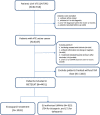Enoxaparin versus dalteparin or tinzaparin in patients with cancer and venous thromboembolism: The RIETECAT study
- PMID: 35664535
- PMCID: PMC9164243
- DOI: 10.1002/rth2.12736
Enoxaparin versus dalteparin or tinzaparin in patients with cancer and venous thromboembolism: The RIETECAT study
Abstract
Background: Venous thromboembolism (VTE) is a frequent complication in patients with cancer and a leading cause of morbidity and death.
Objectives: The objective of the RIETECAT study was to compare the long-term effectiveness and safety of enoxaparin versus dalteparin or tinzaparin for the secondary prevention of VTE in adults with active cancer.
Methods: We used the data from the multicenter, multinational RIETE registry to compare the rates of VTE recurrences, major bleeding, or death over 6 months in patients with active cancer and acute VTE using full doses of enoxaparin versus dalteparin or tinzaparin, and a multivariable Cox proportional hazard model was used to analyze the primary end point.
Results: From January 2009 to June 2018, 4451 patients with active cancer received full doses of the study drugs: enoxaparin, 3526 patients; and dalteparin or tinzaparin, 925 (754 + 171) patients. There was limited difference in VTE recurrences (2.0% vs 2.5%) and mortality rate (19% vs 17%) between the enoxaparin and dalteparin or tinzaparin subgroups. However, there was a slight numerical increase in major bleeding (3.1% vs 1.9%). Propensity score matching confirmed that there were no differences in the risk for VTE recurrences (adjusted hazard ratio [aHR], 0.81; 95% confidence interval [CI], 0.48-1.38), major bleeding (aHR, 1.40; 95% CI, 0.80-2.46), or death (aHR, 1.07; 95% CI, 0.88-1.30) between subgroups.
Conclusions: In RIETECAT, in patients with cancer and VTE receiving full-dose enoxaparin or dalteparin or tinzaparin, no statistically significant differences were observed regarding effectiveness and safety outcomes over a 6-month period.
Keywords: LMWH; cancer; cohort; dalteparin; enoxaparin; recurrences; tinzaparin; venous thromboembolism.
© 2022 The Authors. Research and Practice in Thrombosis and Haemostasis published by Wiley Periodicals LLC on behalf of International Society on Thrombosis and Haemostasis (ISTH).
Figures
References
-
- Monreal M, Falga C, Valdes M, et al. Fatal pulmonary embolism and fatal bleeding in cancer patients with venous thromboembolism: findings from the RIETE registry. J Thromb Haemost. 2006;4:1950‐1956. - PubMed
-
- Trujillo‐Santos J, Nieto J, Tiberio G, et al. Predicting recurrences or major bleeding in cancer patients with venous thromboembolism. Findings from the RIETE registry. Thromb Haemost. 2008;100:435‐439. - PubMed


